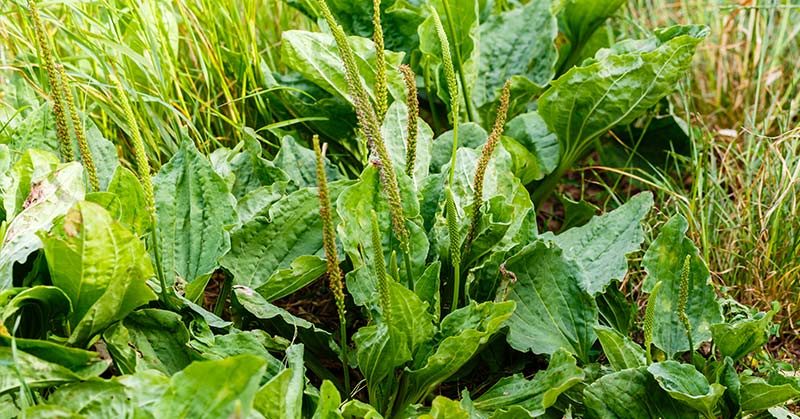You’ve likely seen plantain weed growing all over the place- through cracks in the sidewalk, at the base of fences, and along roadways. You may have even spent an afternoon pulling them out of your lawn and front walkway.
This ubiquitous weed can seem like an annoyance, but you might not want to be so quick to dismiss it. Plantain weed has been used for centuries in traditional medicine and could have some practical applications in your own home.
History of the Plantain Weed
Plantain weed is also known as Plantago major L., or broadleaf plantain. It is native to northern and central Asia and Europe, and ancient Anglo-Saxon people called it “the mother of all herbs”. Early colonists favored the plant as a natural healing remedy and brought it with them to North America.
Because it often grew along well-worn footpaths, the Native Americans often referred to plantain as “white man’s foot”. The Indigenous peoples of North America adopted many of the European uses for the herb, of which there were plenty [1].
For centuries, people have used plantain to treat a variety of health issues, including:
- Wounds
- Skin diseases
- Respiratory illnesses
- Digestive issues
- Problems with reproduction
- Problems with circulation
- Cancer
- To provide pain relief
- To fight infections [2].
Indigenous Americans used plantain weed to draw out the poison of a rattlesnake bite, to soothe muscle or joint pain, to treat battle wounds, and even as an eyewash. They also included the fresh young leaves and seeds in their diet [1].
Medicinal Uses for Plantain Weed
There are several types of plantain weed. The two most common are P. major, which is useful topically for wound healing, and P. lanceolata, which has a multitude of internal uses [3]. While we no longer use this plant to the same extent as the early settlers and Indigenous Americans, it can still provide many of the same benefits. They are as follows:
Anti-Inflammatory
Studies show that the leaves of the plantain weed contain several anti-inflammatory compounds, including flavonoids, terpenoids, glycosides, and tannins [4].
Animal and test-tube studies suggest that the seeds of the plantain weed may decrease several markers of inflammation. They have also shown to slow the growth of cancer cells. Scientists have not evaluated these effects in humans, however, so you should not attempt to use plantain as a cancer remedy [5].
Wound Healing
In one animal study, scientists showed that applying plantain weed extract to wounds helped them to heal faster compared to a control group. This may be due to its anti-inflammatory properties, or its ability to reduce pain [6].
Digestive Support
The seeds of the plantain weed contain a type of fiber called psyllium. Psyllium absorbs water as it moves through your digestive tract, acting as a natural laxative [7]. The leaves, on the other hand, may promote bowel regularity and help treat diarrhea by slowing the movement of your digestive tract [8].
Most of the research specifically relating to plantain weed has only been conducted on animals, so more human research is needed.
Read: 7 of Nature’s Most Powerful Antibiotics
Side Effects to Plantain Weed
Most healthy adults should be able to tolerate plantain without any issues. That being said, there are some potential side effects to watch out for, including:
- Nausea
- Vomiting
- Diarrhea
- Bloating
- Gas
- Skin reactions
Higher doses could trigger more serious allergic reactions that could result in anaphylaxis. For this reason, you should start with small doses of the plant and wait to see how your body reacts to it before increasing your dose [8].
Read: 15 Medicinal Plants That Can Easily Be Grown In Your Yard
How to Identify Plantain Weed
Plantain weed is identifiable by its broad green leaves that are oval to egg-shaped. The leaves grow in a rosette, with thick stems that meet at a base. The leaves can be anywhere from five to thirty centimeters in length. When you break the stems, you will see string-like veins, similar to those that are present in celery.
The plant has flowers that look like compact spikes. They grow on erect, leafless stalks, and each spike is about the size of a pencil. Its tiny, greenish flowers give it a coarsely granular texture [9].
This video gives an excellent overview of what to look for so you know you’ve got a plantain weed, and not something else.
More than Just a Weed
Although it doesn’t look like much, the plantain weed has a variety of uses to address many common health complaints. Although our ancestors used the plant extensively centuries ago, herbal remedies have largely been abandoned in favor of modern medicine.
An increasing number of people, however, are becoming more interested in how we can use nature to improve our health. As such, more studies assessing the uses of plantain, as well as many other plants, may begin to emerge.
Including plantain in your diet may provide certain health benefits, and will likely not cause any harm. It is important to remember, however that if you have any serious health concerns you should talk to a doctor.
Keep Reading: What Weeds Tell You About Your Soil
Sources
- https://www.encyclopedia.com/plants-and-animals/plants/plants/plantain
- https://www.ncbi.nlm.nih.gov/pmc/articles/PMC7142308/
- https://thenaturopathicherbalist.com/herbs/p-q/plantago-lanceolata/
- https://www.ncbi.nlm.nih.gov/pmc/articles/PMC4537734/
- https://pubmed.ncbi.nlm.nih.gov/28839362/
- https://pubmed.ncbi.nlm.nih.gov/23354396/
- https://www.ncbi.nlm.nih.gov/pmc/articles/PMC6358997/
- https://www.ncbi.nlm.nih.gov/pmc/articles/PMC5878035/
- https://www.ediblewildfood.com/broadleaf-plantain.aspx

